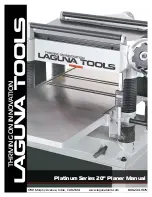
1. Check power line for proper voltage.
2. Inspect all lead connections on motor for loose or open
connections.
1. Inspect cord or plug for damaged insulation and shorted
wires.
2. Inspect all connections on motor for loose or shorted
terminals or worn insulation.
3. Install correct fuses or circuit breakers.
1. Reduce load on motor.
2. Clean out motor to provide normal air circulation.
1. Inspect connections on motor for loose or shorted
terminals or worn insulation.
2. Correct the low voltage conditions.
3. Install correct fuses or circuit breakers.
4. Reduce load on motor.
1. Change speed.
2. Reduce depth of cut.
1. Inspect keys and setscrews. Replace or tighten if
necessary.
2. Tighten fan or shim cover.
3. Replace V-belt.
1. Decrease depth of cut.
2. Sharpen knives.
Increase depth of cut.
Refer to Feed Roller Pressure section for adjustment.
Lift up on unsupported end of board as it enters and exits
cutterhead.
Move chip deflector back 1/8
Replace knives / tips.
” to 1/4” from the cutterhead.
This section covers the most common processing problems encountered in planing and what to do about them. Do
not make any adjustments until planer is unplugged and moving parts have come to a complete stop. See the section
on Wood Characteristics for additional troubleshooting information.
29
TROUBLESHOOTING GUIDE
Motor will not start.
Motor will not start;
fuses or circuit
breakers blow.
Motor overheats.
Motor stalls (resulting
in blown fuses or
tripped circuit).
Machine slows when
operating.
Loud, repetitious
noise coming from
machine.
Machine is loud
when cutting.
Overheats or bogs
down in the cut.
Infeed roller marks
are left on the
workpiece.
Outfeed roller marks
are left on right side
of workpiece.
Cannot control
snipe.
Machine howls on
startup.
Table moves down
while cutting.
1. Low voltage.
2. Open circuit in motor or loose connections.
1. Short circuit in line cord or plug.
2. Short circuit in motor or loose connections.
3. Incorrect fuses or circuit breakers in power line.
1. Motor overloaded.
2. Air circulation through the motor restricted.
1. Short circuit in motor or loose connections.
2. Low voltage.
3. Incorrect fuses or circuit breakers in power line.
4. Motor overloaded.
1. Feed rate too fast.
2. Depth of cut great.
1. Pulley setscrews or keys are missing or loose.
2. Motor fan is hitting the cover.
3. V-belt is defective.
1. Excessive depth of cut.
2. Knives are dull.
Depth of cut too shallow.
Too much spring tension on feed roller.
Long or heavy board sags as it enters and exits.
Chip deflector too close to the cutterhead.
Knives or tip dull.
PROBLEM
LIKELY CAUSE(S)
SOLUTION
Содержание 40260H
Страница 30: ...30...
Страница 31: ...31 N NOTES N...
Страница 41: ...41...
Страница 42: ......
Страница 43: ......















































